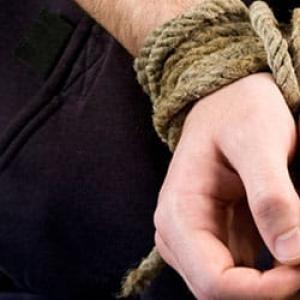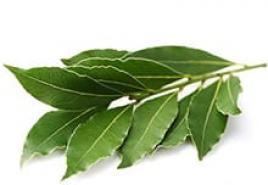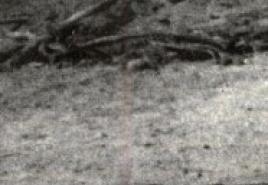Sports fencing with swords. Fencing. Briefly about technology and battle tactics
The rapier blade has a tetrahedral cross-section, thinned towards the end, no more than 90 cm long, the guard diameter is from 9.5 to 12 cm. The length of the assembled rapier is no more than 110 cm and the weight is no more than 500 g.
The rapier is a piercing sporting weapon. Unlike other types of weapons, the rapierist's target surface is the smallest - the torso and neck. In the rules of foil fencing there is a priority, i.e. "tactical correctness" When giving an injection, you must have priority. For example, a rapier player has priority in attack. The opponent must first take the defense and only then will he have priority to retaliate. If the attacks are performed simultaneously, then the thrusts inflicted do not count.
Sword
A sword is also a piercing sporting weapon. The sword blade is more massive than the rapier blade and has a triangular cross-section. The total length of the sword is no more than 110 cm and the weight is no more than 770 g. The diameter of the guard is 13.5 cm. 
Epee fencers have the largest target surface for injection: almost the entire body from head to toe - torso, arms, legs, head. In sword fighting there is no factor of tactical correctness, i.e. Simultaneously inflicted injections are counted towards both opponents.
Saber
The saber has a triangular blade, the length of which is no more than 88 cm. The maximum length of the saber is 105 cm, weight no more than 500 g. 
In fencing combat with sabers, it is allowed to deliver both chopping blows and thrusts. The affected surface is the head, arms and torso up to the waist line. In saber fencing, as in rapier fencing, the decisive factor in awarding a hit is “tactical correctness.”
Modern fencing combat is carried out using electrical equipment to record shots.  The device signals the injection by the athlete by lighting lamps of different colors. If the athlete has injected, the lamp on the device on his side lights up. In rapier and saber fencing, only thrusts made into the target surface are considered valid. Valid injections are marked by lighting colored lamps (red or green), and invalid ones by a white lamp. When the colored and white lamps are lit at the same time, this means that an invalid hit was made first, in which case the valid hit is not counted. In epee fencing, only colored lamps are lit. Since all hits are considered valid, each hit given is counted. When the lamps are lit on both sides simultaneously, each athlete is awarded a shot.
The device signals the injection by the athlete by lighting lamps of different colors. If the athlete has injected, the lamp on the device on his side lights up. In rapier and saber fencing, only thrusts made into the target surface are considered valid. Valid injections are marked by lighting colored lamps (red or green), and invalid ones by a white lamp. When the colored and white lamps are lit at the same time, this means that an invalid hit was made first, in which case the valid hit is not counted. In epee fencing, only colored lamps are lit. Since all hits are considered valid, each hit given is counted. When the lamps are lit on both sides simultaneously, each athlete is awarded a shot.
Team Russia is about those who take real risks.
Silver with bandaged eye
Today's fencing suits reliably protect athletes' bodies from injections. The weapon has become more flexible, and there is a special knob at the tip of the blade. It is impossible to pierce the equipment. But 50-60 years ago, protective equipment was imperfect, and serious incidents on the fencing track were not were rare.
The 1972 Summer Games in Munich were remembered for the Korbut noose, three basketball seconds and a terrorist attack in the Olympic Village. Almost no one talks about the courageous act of fencer Viktor Sidyak. At that Olympics, he became the first Soviet saber fencer in history to win an individual tournament. From Munich he could bring two gold pieces. The USSR national saber team looked stronger than all its competitors and should have won the team tournament.
In the first round, Soviet saber fencers met with Italy. In one of the battles, the blade of the Italian Michele Maffei hit the protective mesh on Sidyak’s helmet, broke, and a fragment of the saber pierced Victor’s cornea. In Munich, the athlete underwent surgery because German doctors were unable to remove the fragment with a magnet. The patient was advised to rest, but the next day Sidyak entered the final of the team tournament (against the same Italians) with a rewound eye. As the athlete recalled, the eye did not hurt, as the anesthesia was in effect, but it was inconvenient to fencing with a bandage. As a result, the Soviet team lost the final, remaining with silver.
Three millimeters to the heart
Sidyak will take team gold four years later in Montreal and at the Games in Moscow. The 1980 Olympics will be his last. At that fencing tournament, tragedy almost happened in the team foil tournament. The most terrible cases in fencing occurred when the blade broke and the pommel could no longer protect. And the rapier breaks more often than other types of weapons.
This was the case in the fight between the USSR and Poland national teams at the Moscow Olympics. Vladimir Lapitsky attacked Adam Roebuck and turned around during the move, and the Pole’s foil broke, which he thrust into the Soviet athlete’s back by inertia. The blade hit the soft tissue of the back and came out of the chest. Lapitsky fell onto the path. Fortunately, vital organs were not affected. The broken rapier passed three millimeters from the heart.
The Italians won the team foil tournament at the 1980 Olympics. The USSR national team was second, the Poles took bronze. In addition to silver, Lapitsky received the award “For Courage” from the Central Committee of the Komsomol, as well as the gold medal of the Games. It was given to the athlete by Italians who visited him in the hospital.
The tragedy of Vladimir Smirnov

Vladimir Smirnov was part of that silver foil team at the 1980 Olympics. At that competition he also won gold in the individual competition. Two years later, the most terrible episode in the history of fencing will happen to him. As a member of the USSR national team, he went to the World Championships in Rome.
During a team tournament against Germany, Smirnov met with Matthias Behr: a mutual attack, the opponent’s blade breaks, the stump pierces the mask and enters the left eye socket. Smirnov is taken to the hospital, where he is placed in an induced coma. It was impossible to save the athlete. The blade penetrated 14 centimeters into the brain. Eight days later, Vladimir was disconnected from the devices.
This tragedy led to changes in equipment: the protection of masks was strengthened, blades became more flexible and became less likely to break. The loads on the tip of the rapier and sword have also changed.
Defenseless Spartakiad
Fewer than ten fatalities have been recorded in the history of sports fencing. Mostly these cases were at the adult professional level. However, the last such tragedy occurred at a youth tournament.
In 2004, the All-Ukrainian Spartakiad was held in Kharkov. Once again the broken rapier became fatal. The blade entered the body of 17-year-old Evgeniy Prokopyev in the area of the right armpit and came out on the opposite side. It pierced both lungs and several major blood vessels. It was not possible to save the young man.
Prokopyev did not have full equipment according to European standards, in particular a side guard, which should protect against such blows. They say that all athletes competed at these competitions without side guards. After this, if participants were missing any required form element, tournaments began to be cancelled.
Dangerous transparent masks
The equipment of fencers has been modernized over time. But not all new products caught on. In 2010, transparent masks began to appear at competitions. Fencing began to lose its entertainment value and, as one of the consequences, the number of events in the Olympic program. The new element of the form was supposed to increase this entertainment. Now fans could see the eyes and emotions of the athletes, and the fencers had increased visibility.
But then the first disadvantages were revealed. When hitting the glass part, not all injections are recorded. In addition, blows to the mask left marks on it, which were very disturbing during the battle. The novelty was finally buried by an incident at the European Junior Championships in Denmark.
In the 1/32 finals of the foil players, Latvian David Gasilovsky met with Italian Francesco Trani. In one of the episodes clear glass Gasilovsky's mask was pierced by a blade. The fragment caused a wound to the athlete in the mouth area. The Latvian did not receive any serious injuries - after medical assistance was provided, the meeting was continued, but for the International Fencing Federation this incident was enough to return to the classic lattice masks.
Equipment will not save you from bruises
Any modern fencing coach explains to parents who bring their child to the class that a blade can leave at most a bruise on the body, but not pierce in any way. The equipment is completely protective. Each type of weapon has its own types of bruises.
If you stab with a sword, it hurts at one point. Terrible pain! And after the saber strikes, my whole back burns. This is a more pleasant pain, or something. At least the usual one. So I always wondered: how do epee fencers endure such pain? But they don’t understand how to adapt to our sensations,” eight-time world champion Alexey Yakimenko told SE.
Essays on the theory and methodology of fencing. M., 1996
Arkadyev V.A. Fencing tactics. M., 1969
Arkadyev V.A. Fencing with foils. M., 1975
Leitman L. Physical training of a fencer. M., 1975
Rodionov A. Psychological preparation of a fencer. M., 1975
Belova E.D. Fencing in the USSR: Retrospective annotated index of literature (1917-1972). Minsk, 1976
Smolyakov Yu.T., Tyshler D.A. Fencing training on swords. Minsk, 1976
Saychuk L. Levels of mastery. M., 1981
Tyshler D.A. Saber fencing. (Competitive activity, athletic ability and specialized skills of fencers). M., 1981
Ponomarev A.N. General issues of sports fencing. M., 1982
Boychenko S.D., Tyshler D.A. Methods of tactical training for a fencer. Minsk, 1983
Tyshler D.A. Fencing stories. M., 1983
Arkadyev V.A., Lyubetskaya T.L. Dialogue about the fight. M., 1986
Ponomarev A.N. Fencing: from beginner to master. M., 1987
Daggers: fencing systems of the East. Minsk, 1993
Romanov N.N. Climbing Olympus. M., 1993
Tyshler G.D., Tyshler D.A. What an athlete should know about technique and tactics. M., 1995
Kalmykov E.V. Individual style of activity in combat sports. M., 1996
Koroleva A.P. History of fencing. Fencing in ancient world and in the Middle Ages. M., 1996
Sports fencing. Textbook for universities physical culture. Ed. D. Tyshler. M., 1997
Tyshler D.A., Tyshler G.D. Saber fencing. M., 1998
Taras A.E. Combat fencing technique. Minsk, 1999
Bazarevich V. et al. Fencing. What athletes and coaches should know about refereeing and competitions. M., 2000
Lyubetskaya T.L. Arkadyev brothers. M., 2000
Rules sports games and competitions: Illustrated encyclopedic reference book. Per. from English Minsk, 2000
Movshovich A.D., Tyshler G.D., Tyshler D.A. Long-term training of young fencers. M., 2002
Mishenev S.V. History of European fencing. M., 2004
Movshovich A.D., Tyshler D.A. The art of stage fencing. M., 2004
Tyshler D.A. Your saber, maestro! M., 2004
Find "Fencing" on
The Polish school of saber fencing appeared almost simultaneously with the widespread spread of the saber in the Polish-Lithuanian Commonwealth and after some time earned a reputation as one of the strongest in Europe. Things got to the point that in the 18th century. even the Turks seriously argued that the historical homeland of the saber was... precisely Poland - so great was the glory of the Polish swordsmen.

In the 17th century A very specific style of saber fencing had already appeared, as evidenced by the then saying: “The Hungarian hits backhand, the Muscovite hits from top to bottom, the Turchin hits towards himself, and the Pole waves his saber “on the edge.” The phrase “on the edge” contained precisely the originality of the Polish method of saber combat.
This method of fighting received the name “sztuka krzyzowa” in Poland, because during fencing, the blades of sabers, intersecting with each other while parrying blows, seemed to form a cross, that is, they intersected at a right angle. Since the handles of Polish sabers did not have developed guards, like swords, for example, the Poles used the so-called dlugi zaslony (long guards) - they turned the saber over with the blade down so that the enemy weapon would not hit the unprotected hand when sliding.
Types of saber strikes.
In Polish saber fencing, the following main types of strikes were distinguished:
1) a longitudinal blow from top to bottom, called “head”;
2) longitudinal blow from bottom to top, under the chin;
3) a horizontal blow between the thigh and shoulder blade, called the “father’s blow”;
4) a vertical blow from the left shoulder or left ear diagonally to the right side through the chest - “referendar blow”;
5) horizontal blow to the left side of the head (cheek);
6) a vertical blow from the left side, turning the blade with the tip up, to the right shoulder across the chest diagonally, called the “senator blow”.
The saber strikes themselves were divided into the following main types according to their effectiveness:
1) a direct, pushing blow - it was not very strong, but very fast and accurate, this blow could be used in fights both at short and relatively long distances, both in a fight with a single enemy on foot, and in equestrian combat (especially during general clashes), when it became necessary to deliver many very fast blows in different directions;
2) a cutting blow (the so-called cleaver), applied from an elbow or shoulder swing, resulting in a very strong effect; such a blow was used primarily in foot combat at short distances (even against an enemy who could be partially protected by armor);
3) a stretching blow, when the saber blade was, as it were, dragged along the enemy’s body with its movement, applied with a swing from the shoulder, which gave a great effect during the fight and at relatively distant distances, such blows were used to cut the enemy’s body or his weapons, with their help it was possible inflict cutting wounds with the end of a blade in a horse or foot duel.
I must say that Various types Polish sabers were structurally adapted for a certain style of fighting. So, for example, sabers of the Hungarian-Polish type were used to deliver so-called, using Polish fencing terminology, club blows, most often when swinging from the shoulder, which was greatly facilitated by a well-developed feather at the end of the blade. Karabela, thanks to the design of its handle, which created a good support for the little finger, was used for arcing or protracting strikes.
In addition to slashing blows, piercing blows were often used in saber combat, but they were noticeably different in nature from thrusts inflicted, say, with a sword. Due to the curvature of the blade, it was very difficult to make a direct thrust with a saber, but thanks to it, it was perfect for striking from the side, from below or from above, which was of no small importance for fighting such an enemy as, for example, a Turk armed with a round shield.
Punch to the stomach from below

b) InjectionsA shot from the top line |
|
|
Bottom position |
|
|
High position |
|
|
Hit the hand from the inside |
|
|
Hit the hand from below |
|
Based on Polish textual sources dating from the 17th century, we can conclude that:
a) most of the saber fights, both in war and in peacetime, were carried out on foot and with a single enemy [Perhaps this is due to the fact that the noblewoman, even during military operations, was accompanied by a retinue of military slaves, who “pulled” similar accompaniment of his opponents, allowing eminent warriors to conduct a semblance of duels without getting involved in a mass battle.];
b) for every 19 hits, 14 were on the hand (in particular, on thumb) and 5 - to the head: “...after the second or third blow I cut off his fingers,” “...he had to fight with Snarsky, whose finger he cut off”;
c) defense with weapons and retaliatory attacks were often used: “...he grabbed me so hard, so that the saber shook in his fist - he withstood the attack. We fought with him ten more times - neither for me nor for him”;
d) the tactics of a battle between mounted opponents often resembled a foot battle. Consequently, leaving the line of attack by jumping or stepping back had a subordinate role (compared to the same rebounds) and was used to the same extent as the maneuver of a rider spurring and reining in a horse at a short gait.
At first they learned how to use a saber individually, in much the same way as medieval knights, that is, from their father or some other relative, or from a person who himself knew how to fence well and participated in military campaigns. The striking technique was practiced using “fingers” - wooden sticks, on which training matches were held, often independently, as entertainment, which helped to better assimilate fencing wisdom.
Fencing is one of five sports that are included in the program of all Olympic Games.
It appeared in the program for the first time in 1896 Since 1900- Olympic tournaments were already held on all types of weapons used now.
When did fencing become a sport?

As the art of wielding piercing weapons, fencing originated in the 15th century in Spain. A little later, associations of fencing teachers were created in Germany and England.
In the 16th century in Italy first established the principles of fencing. A theoretical course on its study was created. This period can be considered the birth of fencing as a sport.
Its first international charter of rules was defined in 1914, although at that time fencing was already considered a separate species sports, and was included in the program of the Olympic Games. In 1921 held the first world championship, organized a little earlier by the created International Fencing Federation.
Reference. The first competitions similar to modern tournaments were held 3 thousand years ago in Egypt, India, Ancient Greece, Rome, Japan and China. Ancient frescoes speak about this.
What types of this sport are there now?
In modern fencing, three types of weapons are used: sword, rapier and saber.
Sword
It is a piercing weapon. This type considered the most common. The fight is the closest thing to dangerous combat fencing.

Photo 1. Epee for sports fencing. At the end of the blade there is a special electronic tip that records the injections.
This type of fencing the heaviest of the three. In particular, the weight of the sword is more than 700 g.
This type of fight has the following features:
- Any part of the body can be affected: the torso, head or limbs, as well as the equipment and clothing of the fencer. In this case, points are awarded for any injection.
- Points for injections that opponents inflicted simultaneously on each other, both are counted at once.
- Sword fights usually last a long time due to the fact that opponents choose a waiting strategy, since it is very easy to get a shot and a point for it.
- Many believe that a tall athlete with long arms has an advantage in a fight. However This theory has no statistical evidence: In international tournaments, fencers of different heights win.
Rapier
It is a piercing sporting weapon. Among the three types, it is considered the safest, therefore women and children aged from 10 to 12 years. She has a relatively light weight - 500 g, and the length is the same as that of a sword - 110 cm.

Differences in rapier fighting:
- The surface of the body that can be hit with a rapier and get a point, the smallest among the three types of fencing. In particular, this is the torso and neck ( Bottom part tongue of the mask).
- There is a so-called concept of priority or “tactical correctness.” This rule is that the enemy first needs to repel the attack and thus gain priority before striking back.
- If there is a double attack (simultaneous), No points will be awarded for possible injections.
Important! Fencing with foils considered the base species which all athletes must master. After this, they either choose another profile (épée or saber) or remain foil fighters.
Saber
Unlike the first two types (sword and rapier), a saber is not only a piercing weapon, but also a cutting weapon. Its weight is the same as that of a rapier, but the length is different: 5 cm less.

The main feature of this type of fencing is that here points are awarded for both injections and strikes. In this case, the blow can be delivered by the entire surface of the blade or its butt.
Features of saber fencing:
- May be affected head (mask), arms and torso.
- In addition to hitting to score a point, priority must be given in the same way as in the case of rapiers.
- Saber fencing is more dynamic and entertaining. Athletes perform all actions very quickly.
- In this form, time is not recorded.
You might also be interested in:
Athletes who have achieved great results
The most famous fencers:
Among men:
- Aladar Gerevich. In addition to the huge number of medals received at European and world championships, this Hungarian fencer could boast 10 medals on Olympic Games. Among them were 7 gold. He is also known as a long-lived athlete who lived 81 years old. The athlete died in 1991.

Photo 2. Professional fencer Aladar Gerevich. In his hands the athlete holds a sports saber and a protective mask.
- Edoardo Mangiarotti is from Italy. In total, he won 39 medals at world tournaments and the Olympic Games. He specialized in fencing with epee and rapier.
- Nedo Nadi. This athlete received great respect thanks to 5 gold medals, which he won during one Olympic tournament. At the same time, he became the first fencer to take gold in three types of weapons at once.
Among women:
- Elena Belova. Soviet athlete who became an Olympic champion four times. In addition, she repeatedly won international tournaments and competitions in the USSR. Elena is the only Olympic champion in the history of Soviet fencing who won individual bouts.
- Maria Vezzali. This woman is considered one of the best fencers in the world thanks to 6 victories at the Olympic Games, 16 at world championships and 13 at European tournaments. The athlete won 5 Olympic medals in one personal discipline.
- Irina Embrich. Estonian fencer, was recognized as the best in this sport in her country in 2007. Irina is a multiple winner of world, European and Estonian championships.
What are the benefits of sport fencing?
Playing sports is good for health. Fencing is no exception. Fights with swords, rapiers or sabers are useful for the following:

- All muscle groups are trained, the figure of a man is tightened.
- Developing speed of reaction, coordination, agility, endurance, attention.
- Begin to function well cardiovascular and respiratory systems.
- Thanks to cyclical and dynamic work, the body dumps ballast in the form of excess fat deposits.
- Develops the ability to make quick decisions in difficult situations.












